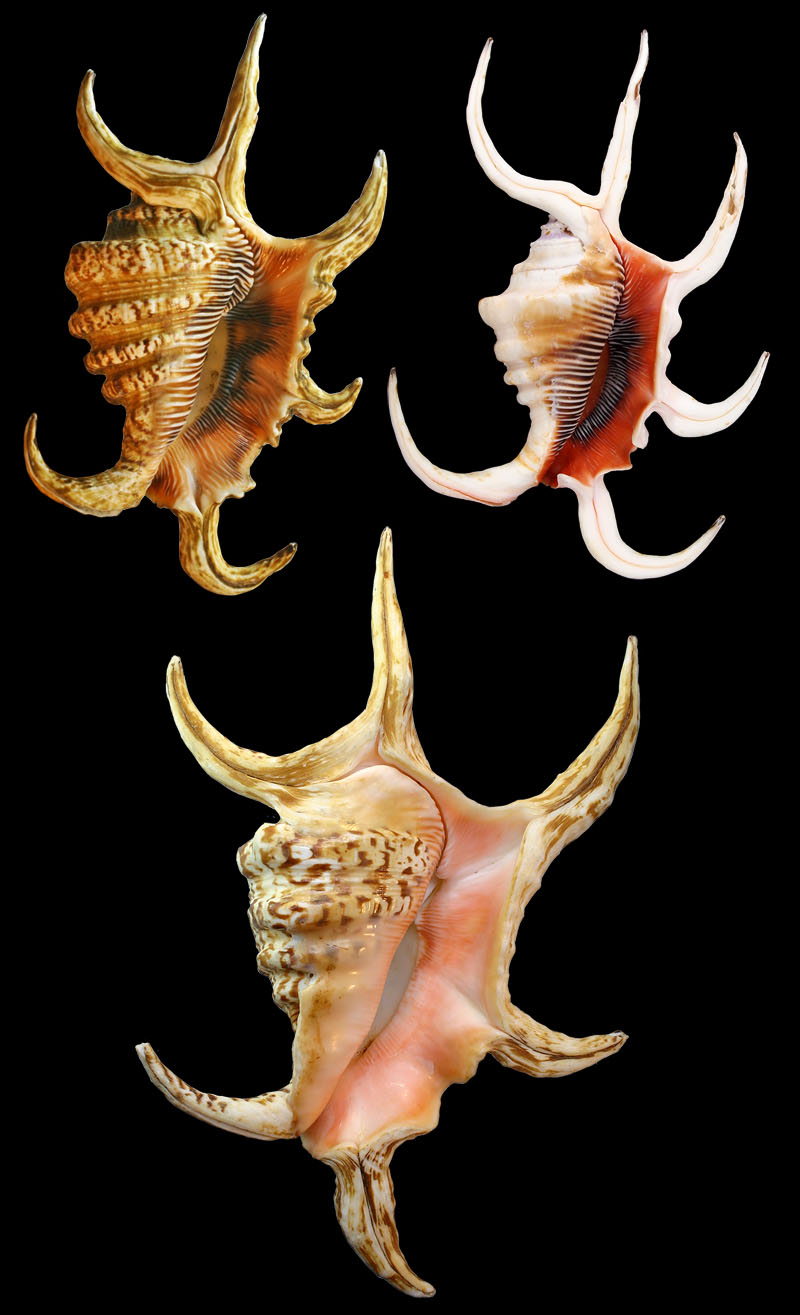Stromboidea
Type species: Lambis harpago Röding, 1798, by tautonomy [Strombus chiragra Linnaeus, 1758]
Mörch, 1852 cites "Harpago Kl.", which is a reference to Klein, 1753, a pre-Linnean work. Mörch defines Harpago as being a subgenus of Pterocera Lamarck. He includes 3 species in this group: Pterocera chiragra, Pterocera arthritica and Pterocera pseudoscorpio.
Harpago species are:
- top left: Harpago arthrithica
- top right: Harpago rugosa
- bottom: Harpago chiragra (female)
Harpago is often treated as subgenus of Lambis. Following Kronenberg, 2008 it is treated here as separate genus.
There are intergeneric hybrids known:
History and Synonymy
- Syn.: Bothrodon Kerr, 1926: 314
- Syn.: Harpagus Vernus, 1892: 651
1753
Klein, 1753 describes the genus Harpago as:
- "Harpago
- §.252. Ab uncis dicitur TROCHO.CONUS, labiosus, torosus, tympanosus, in sex murices acutos & aduncos fissus. Ultimus ad mucronem longissimus; duo sequentes & fibi oppositi sunt recurvi, inflar cornu bovini; reliqui tres breviores, valde adunci. Testa ab extra alba; maculis fuscis picta. Pentadactylus, Plinii. Vpf-vinger-krab / Bootshaak / Duivelsklaauw / Belg."
1926
Kerr, 1926: Bothrodon pridii
2014
Bouchet, 2014:
- "Described as the fang of a giant fossil snake, but shown by Quenstedt [in Kuhn, 1939, Fossilium Catalogus, I, Pars 86: 25] to be a finger-like process of Harpago chiragra."
Reports
Ashley Field on Harpago in Queensland State, north east Australia:
- "In general Harpago chiragra and Harpago rugosus do not occur in the same area here in Queensland but both have been recorded from Helix Reef which is far offshore from Townsville, so they could potentially occur together. I have also never come across a specimens that could not be readily identified as H. chiragra or H. rugosus. In general Harpago chiragra occurs on the Great Barrier Reef and Harpago rugosus on the Coral Sea Reefs but there are some isolated reefs which could have both together. They differ a bit in their behaviour and habitat as well. Harpago chiragra usually occurs on the seaward margin in shallow water on the hard platform of reefs in the Great Barrier Reef, conversely Harpago rugosus appears to be a lagoon dwelling shell and is from somewhat deeper habitats. Harpago chiragra is conchologically sexually dimorphic whereas H. rugosus is much less dimorphic and males and females can be hard to distinguish. Together they are very interesting species as they both have quite a different capsize behaviour to other spider shells."
References
- Bouchet, P. (2014). Bothrodon pridii Kerr, 1926. Accessed through: World Register of Marine Species at http://www.marinespecies.org/aphia.php?p=taxdetails&id=760461 on 2014-05-16
- John Graham Kerr, “Bothrodon pridii, an Extinct Serpent of Gigantic Dimensions,” Proceedings of the Royal Society of Edinburgh 46 (1926): 314–315
- Klein, 1753; Tentamen methodi ostracologicæ, sive Dispositio naturalis cochlidum et concharum in suas classes, genera et species, iconibus singolorum generum aeri incisis illustrata: Accedit lucubratiuncula de formatione, cremento et coloribus testarum quæ sunt cochlidum et concharum. Tum commentariolum in ..., apud G.J. Wishoff, Conr. fil., 1753, pp. 237
- A. Meredith, 2013. The Harpago complex: a collector's guide; American Conchologist, vol. 41(4), p. 10-16
- Mörch, O. A. L. 1852. Catalogus Conchyliorum quae Reliquit D. Alphonso d'Aguirra & Gadea Comes de Yoldi. Fasciculus Primus. [vi] + 170 pp. Hafniae. Fulltext
- Roeding, 1798

